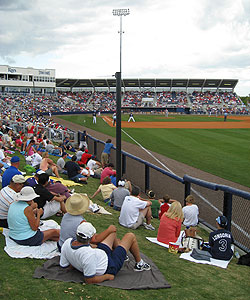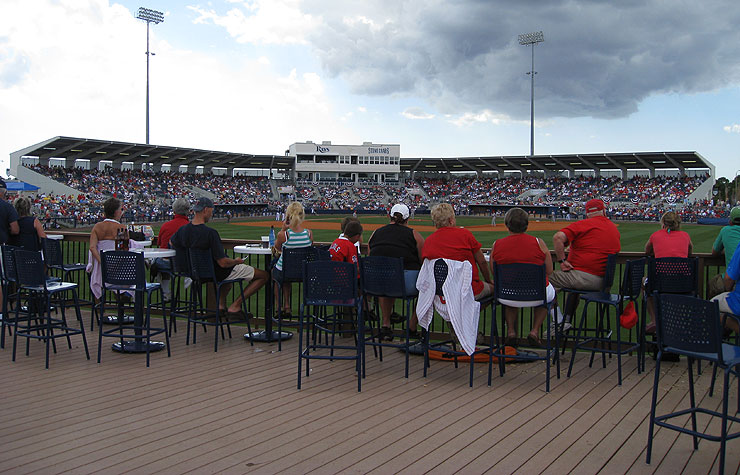
|
For 15 years the Texas Rangers called Charlotte County Stadium their spring training home. But the Rangers left after the 2002 season, heading west to Arizona for a newer and bigger ballpark in the city of Surprise. That left the ballpark in Port Charlotte without a Grapefruit League tenant and, because it was a rather pedestrian facility to begin with, it seemed unlikely another Major League team would ever move in.
And that would be partially true, as the stadium as it existed during the Rangers tenure was stripped to its skeleton in 2007. But spring training once again returned to Port Charlotte in 2009 when the Tampa Bay Rays decided to relocate there after reaching an agreement with the county to rebuild the stadium and bring it up to modern state-of-the-art standards. The $27.2 million needed to do so was more than five times the original $5 million construction cost and when the extensive renovations were completed the Rays new spring training home was literally new itself. The improved stadium, designed by HOK Sport, has a berm down each baseline, suites and a total capacity of 6,823, fixed seats accounting for 5,028 of the total with general admission (berm) making up most of the rest. The berm was originally to have been built around the outfield but that turned out to be cost prohibitive and problematic, as the reclaim storm water lakes next to the ballpark would not allow for an earth berm to be constructed there. Instead, a 19,000-square-foot wooden boardwalk was built in its place, becoming the signature feature of the Rays' spring digs. Known as the Baseball Boardwalk, itís home to a tiki hut in center field that operates as a full service bar before, during and well after games, as it stays open 90 minutes following the last pitch. Replica vintage baseball cards are beneath the tiki hutís glass countertops and fans seated at the bar rest their beers on top of the posed photos of Lefty Gomez, Mel Ott and other players from yesteryear. Fans can also rest drinks of their choice on the railings that surround the stadiumís sole scoreboard, which was built into the boardwalk a short distance from the tiki bar. The boardwalk is also littered with deck chairs, many reserved for private and catered parties. Standing room is plentiful along the length of the boardwalkís planks, including behind each teamís bullpen Ė the Rays in right field and the visitorís in left. The wooden boardwalk attaches to the interior concrete aisle that encircles the ballpark and separates the box and reserved seats in the grandstand. Most reserved seats (200-level) are either covered by a roof are shaded by it.
The dugouts are anything but small and are so expansive that fans can easily peer into them from many seats in the grandstand, which is the stadiumís biggest flaw. Rather than raze it and start over, the position of the grandstand remains the same as when it was constructed in the mid-1980s. This forces the concession stands that serve most fans to be behind the grandstand, which is a minor annoyance in an era when open concourses have become the de facto standard. But the biggest problem with the grandstand is that it's angled behind home plate instead of being gently curved, which means seats in general are further away from the field than necessary while those seated in what are normally good sections near the on-deck circle have to put up with seats that are poorly angled. The ballpark in Kissimmee, which the original Charlotte County Stadium was clearly patterned after, has a similarly shaped grandstand that causes similar problems for fans sitting in the angled corners behind home plate. Although both ballparks underwent extensive renovations two decades after they opened, there was no way to fix the grandstand in either without leveling and rebuilding it. In both cases, that wasnít on the agenda because it wasnít in the budget. With the going rate for spring training ballparks reaching the $100 million plateau in 2009, the designers in Port Charlotte didnít have the funds Goodyear ($108M) and Glendale ($100M) had at their disposal, so they instead opted to replace the grandstand's original seats, adding cup holders to them in the process, and focus on the exterior of the ballpark, which was in dire need of an aesthetic improvement. That mission was accomplished with flying colors. Charlotte County Stadium had one of the ugliest exteriors Iíve ever seen. Its appearance resembled that of an oversized ice box. Big, white and square, it lacked any flair. Thatís not the case any more, as the exterior facade was transformed into a much more open, angular and colorful edifice made of various materials, including glass. Besides the press box and suites, the extremely made over structure contains a 2,800-square-foot team store. Although the original gravel pathway in the parking lot did not get paved, the drop off point that was added outside of the home plate entrance did. The gate at home plate serves as the stadiumís main entrance. Two much lesser used gates are found behind first and third base. Renovations, which began on August 20, 2007, were mostly finished by January 2009 and included the construction of new administrative offices and a 44,000-square-foot clubhouse, all of which occupy the two story building behind right field. Near the players clubhouse is the Kids Clubhouse, which contains a small playground placed atop mulch. The Kids Clubhouse is at the end of the street level first base concourse. Above it is a picnic patio, but most of the blue picnic tables on it have no view of the playing field, which was refurbished and ever so slightly expanded for 2009. Previously the outfield dimensions were 338' down the lines and 402' to center. Now they are 343' and 414' respectively. The cost of the stadium's renovations were borne by three parties, the biggest chunk ($15 million) coming from the state of Florida. The Rays contributed $4 million to the project and Charlotte County was responsible for the remainder. The county's share will come from a 1% hotel bed tax increase, which is expected to generate $450,000 per year for the life of the Rays' 20-year lease. As part of the county's contract with the Rays, the team can sell naming rights to the ballpark and will get to keep all of the proceeds when they do so. In the meantime, the completely renovated Charlotte County Stadium will sport a slightly modified name as it was reborn as Charlotte Sports Park.
Location and ParkingThe stadium sits on the same spot as it did when it first opened in 1987. Framed by manmade ponds and palm trees, itís a good eight miles from I-75, where the four-lane Toledo Blade Boulevard exit (#179) turns into a two-lane road before dead-ending into State Route 776, which is locally known as El Jobean Road and the location of Charlotte Sports Park. Except for a small strip of storefronts on the stadiumís side of the highway, very little commercial development has taken place near it. The Charlotte County Fair Grounds is across the street and their parking lot handles all overflow from the stadiumís grass and gravel lot, which can hold up to 1,500 cars in an expansive field that extends from behind the stadiumís first base grandstand.
Charlotte Sports Park Footnotes
| |||||||||||||||||||||||||||||||||||||||||||||||||||||||||||||||||||||||||||||||||||||||||||||||||||||||||||||||||||||||||||||||||||


 Where the grandstand ends is where the dual berms begin and behind each are concession carts set up under large blue canopies. The first baseline berm is smaller than the berm down the third baseline, which wraps around the left field foul pole. The same area in right field is occupied by a party deck. Fans sitting there get better treatment than some members of the media, as the press box is a tad on the small side. As a result, auxiliary seating for the media was placed within section 207, where the top four rows are comprised of folding chairs and tabletops.
Where the grandstand ends is where the dual berms begin and behind each are concession carts set up under large blue canopies. The first baseline berm is smaller than the berm down the third baseline, which wraps around the left field foul pole. The same area in right field is occupied by a party deck. Fans sitting there get better treatment than some members of the media, as the press box is a tad on the small side. As a result, auxiliary seating for the media was placed within section 207, where the top four rows are comprised of folding chairs and tabletops.


